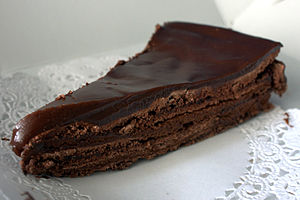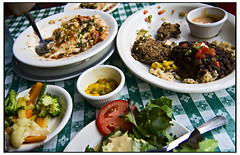 Image via Wikipedia
Image via WikipediaThis is quite a bit non-ordinary article: the cook slaughters and cooks and eats the poultry or meat from animals she knew - by growing and caring for them.
Is there a twist? Is there a catch somewhere?
Find that out yourself. Read on!
-----
Sep. 4, 2010
WESTMINSTER WEST — A fluffy white sheep skin was draped over the window seat in the spacious, light-filled kitchen of Deborah Krasner’s home, a converted 18th-century hay barn surrounded by meadows just outside of Putney.
“That was Meringue,” she said matter-of-factly, referring to one of the Icelandic lambs she and her husband, Michael, raised a couple of years ago. “The one in the other room was Salt. The first two we had were called Shank and Burger.”
Krasner, a
James Beard award-winning cookbook author, kitchen designer and cooking teacher, is fully aware that most people recommend against naming animals you plan to eat.
She addresses that subject directly in her new book, “Good Meat” (Stewart, Tabori & Chang, 2010), which focuses on how to source and cook sustainably-raised,
grass-fed and pastured meat and eggs, and offers a personal perspective on raising your own lamb, geese, ducks, chickens (for meat and eggs) and even
guinea fowl.
Go ahead and name your animals, Krasner writes. “Of course, when you go to eat them, it’s not easy knowing you are eating, say, Sally. But on the other hand, it’s nearly as hard to eat steer number 34, if you’ve known him and cared for him all his life. The central question is this: How can you reconcile the affection you inevitably feel for an animal you live with and tenderly care for, knowing at the same time that you are also the agent of its death and destiny as food — especially your own food, and not that of a stranger?”
It all comes down to respect, Krasner explained last week as she demonstrated a roast guinea fowl recipe from the cookbook using one of her birds, along with eggs poached in tomato sauce made with fresh eggs from the couple’s laying flock.
The sheep meadow and the hen house, both viewable from the kitchen window, are quiet now, Krasner said with some regret. She had just sold the birds because she will be on the road this fall promoting the book, her seventh, while her husband commutes to his job as a political science professor at
Queens College in New York.
“All I can do is give them the best life I can give them, but they’re not pets,” Krasner said as she stuffed the guinea fowl with a mixture of apples, toasted almonds, thyme and lemon zest. “Like anyone who’s raised a vegetable knows, you value that vegetable. You treat it with respect,” she added. “When you eat meat bought directly from the farmer, who has raised that hen from a chick or cow from a calf, you have to respect it. When you buy a piece of meat from a supermarket, you don’t think about how to respect it.”
Krasner knows that most of her readers won’t raise their own meat. However, over her 30-plus years as a
culinary professional, she has observed a significant increase in
Americans buying grass-fed meat at farmers markets, community-supported agriculture shares (CSAs), farm stands or through small specialty butchers, who buy whole animals from farmers.
A conversation with a student on one of the culinary vacations Krasner hosts planted the seed for “Good Meat,” she said.
For the last eight to 10 years, the Krasners had been sourcing most of their food, including meat, from a very small area around their southern Vermont home.
“I thought it was a Vermont thing, or at least a rural thing,” Krasner said, “until this guest told me that it was happening in urban Minnesota, too.”
The handsomely designed and beautifully photographed book was close to three years in the making. “It is about what is good meat; how do you find it, how do you cook it and eat it, and how it tastes different,” Krasner said as she trussed the legs of the guinea fowl. (“Julia (Child) always used to say it looks so wanton if you don’t,” she joked, “but it also keeps the stuffing in.”)
Krasner firmly believes that raising meat on grass is better for the animals, the planet and for the people who eat it. (See sidebar) She does acknowledge that it cooks and eats differently than the “relatively flaccid, fatty” confined and corn-fed
meats Americans are used to. “You have to cook it more tenderly with lower heat and pay a little more attention to it,” she said.
The book includes more than 200 recipes for grass-fed meats from beef to rabbit, as well as eggs and side dishes, with a global menu of mouthwatering recipes ranging from Madras Coconut Cream Beef Curry, to Steamed Tofu with
Ground Pork and Shrimp, to Roasted Cardamom, Oregano and Garlic
Chicken Thighs. (Full disclosure: I helped Krasner out as an unpaid recipe-tester last year while living in
New Zealand where beef and lamb are almost exclusively raised on pasture.)
Although some do call for less familiar ingredients (beyond the meats), there are plenty of recipes that are quite straightforward like Roasted and Glazed Lemon Chicken and Strip Loin Steak with Garlic and Red Wine Sauce — and even those simpler recipes offer nuggets of culinary insight. Krasner knows home cooks and “I do home food,” she said.
Each chapter includes helpful photographs and drawings of the featured animal with detailed descriptions of cuts, including how to write a custom butcher cut sheet for your animals, or for the half of a lamb or eighth of a cow you might buy direct from a farmer.
It will also be indispensable to farmers market shoppers who want to support their local farmers by buying more than lamb loin chops or ground beef, but don’t quite know what to do with beef kidneys (blanch then saute with red wine, mushrooms and garlic and finish with a little sour cream and mustard) or pig ears (fry crisp and use as garnish for spiced yellow split pea soup).
“We’ve lost our ability to cook anything more than steaks, burgers and chops,” Krasner wrote in the book’s introduction before proceeding to offer reassuring and clear advice on how to cook almost everything from head to tail. As she notes in her recipe for fried beef testicles: “Nearly anything deep-fried and doused with hot sauce tastes delicious.”
“Part of respecting the animal is cooking all of it including tongues, ears, shank, tail and offal,” Krasner said over the guinea fowl lunch. “It’s just not OK to know that all those other bits are going into pet food.”
If you’re willing and able to buy in bulk and buy more than just the chops and steaks, Krasner pointed out, locally raised grass-fed meat is affordable — and delicious.
“It’s a gift to all of us,” she concluded.
Contact Melissa Pasanen at mpasanen@aol.com.
-----
There are comments and some other articles that might interest you. Follow the source article below.
Taken from burlingtonfreepress.com; source article is below:

















